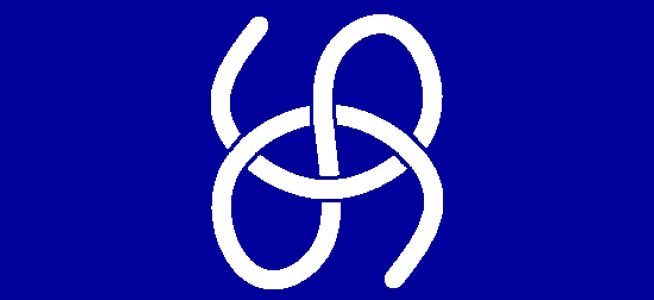Next Saturday is Bloomsday, the anniversary of the date on which the action of Ulysses took place. Mathematical themes occur occasionally throughout Ulysses, most notably in the penultimate episode, Ithaca, where the exchanges between Leopold Bloom and Stephen Dedalus frequently touch on weighty scientific matters. [Last week’s ThatsMaths post]

In Ithaca, the narrator takes every opportunity to express ideas in mathematical terms. The opening question of this catechetical episode is “What parallel courses did Bloom and Stephen follow returning?” Joyce’s knowledge of geometry was not confined entirely to Euclid: his notes make mention of Nikolai Ivanov Lobachevsky, one of the founders of non-Euclidean geometry. Towards the end of the episode the narrator asks “How did they take leave, one of the other, in separation?” The answer is an abstruse amalgam of perpendicular lines and obtuse angles.
Although there is no real mathematics in Ulysses, there are numerous hints and allusions in the text. Joyce remarked in a letter to Harriet Shaw Weaver that the Ithaca episode should be read by some person who is “a physicist, mathematician and astronomer and a number of other things.” Not noted for his modesty, Joyce was here asking for qualifications in his readers that he himself did not possess!
In their article in the James Joyce Quarterly – Nought nowhere was never reached: Mathematics in Ulysses – Ray Mines and Reed Way Dasenbrock present arguments for the mathematical significance of several passages in Ulysses. Joyce may have had only a vague understanding of mathematical analysis (calculus) but he was intrigued with the concept of limit. This is shown by a response at the end of the Ithaca episode: “dividends and divisors ever diminishing without actual division till, if the progress were carried far enough, nought never was nowhere reached.” This is clearly based on the definition of the derivative, or differential coefficient, of a function.
The Foundations of Mathematics
During the years when Joyce was in Zurich (1915–1919), there was frenzied mathematical activity there in a struggle to find firm foundations for mathematics. Gottlob Frege’s attempt to construct a solid basis for the subject had been demolished by a paradox formulated by Bertrand Russell: the concept of the set of all sets has to be outlawed if contradictions are to be avoided. Joyce had read Russell’s Introduction to Mathematical Philosophy, published in 1919. This work examines the foundations of mathematics and would have introduced Joyce to contemporary thinking in a rapidly developing discipline.

The paradox, normally ascribed to Russell, was actually discovered earlier by Ernst Zermelo, and this impelled Zermelo and others to develop a consistent set of axioms for set theory, the basis of mathematics. The result was the Zermelo-Fraenkel axioms, still considered the standard system for set theory. Zermelo held the Chair of Mathematics in Zurich from 1910 to 1916. Mines and Dasenbrock speculate about an intriguing if unverifiable possibility: could Joyce have met Zermelo in Zurich, or at least been aware of the dramatic mathematical developments under way while he was in that city. We will probably never know.
Sources
Ray Mines and Reed Way Dasenbrock, 1997: Nought nowhere was never reached: Mathematics in Ulysses. James Joyce Quarterly, 35, 1, 25-36. JSTOR
MacTutor article on Ernst Zermelo.
